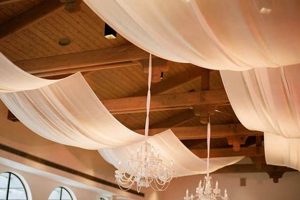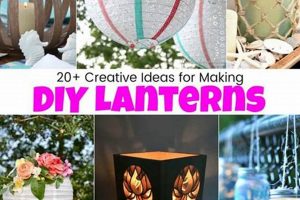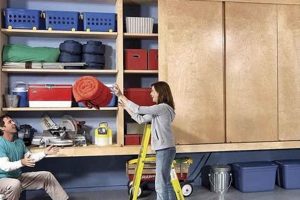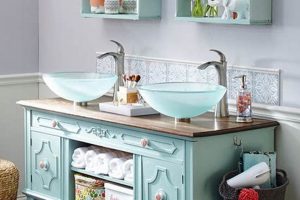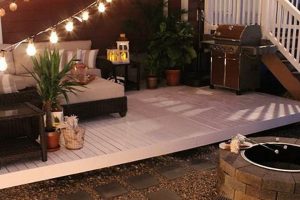The concept involves creating personalized containers for plants through do-it-yourself methods. This encompasses a range of techniques, from repurposing existing materials to crafting entirely new vessels from readily available resources. For example, an individual might transform an old tire into a painted planter or construct a terracotta pot from clay.
Constructing personalized plant containers offers numerous advantages, including cost savings, creative expression, and environmental consciousness through upcycling. Historically, resourceful gardeners have adapted found objects for planting, reflecting a tradition of self-sufficiency and resourcefulness. This approach reduces reliance on commercially manufactured products and allows for unique, individualized garden aesthetics.
The following sections will explore a variety of methods for creating plant receptacles, highlighting both simple and more advanced techniques for constructing visually appealing and functional garden features. Specific materials, tools, and design considerations will be detailed to provide a practical guide for creating personalized planting solutions.
Essential Guidance for Creating Personalized Plant Containers
Achieving successful and aesthetically pleasing homemade plant containers requires careful planning and execution. These tips address key considerations for constructing durable and functional receptacles.
Tip 1: Material Selection is Paramount. Prioritize materials that can withstand exposure to moisture and sunlight. Untreated wood will degrade rapidly, whereas certain plastics may become brittle. Consider using treated lumber, concrete, or recycled materials designed for outdoor use.
Tip 2: Drainage is Critical. Ensure adequate drainage holes are incorporated into the design. Stagnant water promotes root rot, hindering plant growth. A layer of gravel or broken pottery at the bottom of the container can further improve drainage.
Tip 3: Consider Plant Size and Growth Habits. Choose a container size appropriate for the mature size of the intended plant. Select larger containers for plants with extensive root systems. Overcrowding can impede growth and nutrient absorption.
Tip 4: Reinforce Structural Integrity. For larger or heavier containers, reinforce the structure to prevent collapse. Use sturdy fasteners, such as screws or bolts, and consider adding internal supports to distribute weight evenly.
Tip 5: Weather Resistance is Essential. Apply sealant or protective coatings to protect the container from the elements. This will prolong its lifespan and prevent degradation due to moisture, UV radiation, and temperature fluctuations.
Tip 6: Incorporate Visual Appeal. While functionality is crucial, consider aesthetic elements. Experiment with different colors, textures, and shapes to complement the surrounding garden environment.
Tip 7: Test Stability Before Planting. Ensure the finished container is stable and will not easily tip over. Uneven surfaces or top-heavy designs can pose a hazard, especially in windy conditions. Add weight to the base if necessary.
By carefully considering these points, individuals can construct long-lasting, functional, and visually appealing planting vessels that enhance their outdoor spaces.
The following section will provide specific project ideas for creating personalized planting solutions, showcasing various material and design approaches.
1. Material Sustainability
Material sustainability within the context of personalized plant container creation represents a critical convergence of environmental responsibility and resourcefulness. The selection of materials significantly impacts the ecological footprint of gardening practices and promotes long-term environmental well-being.
- Upcycled Materials: Reducing Waste Streams
The incorporation of upcycled materials, such as repurposed tires, plastic bottles, or metal containers, diverts waste from landfills and reduces the demand for newly manufactured goods. This strategy lowers the energy consumption and pollution associated with resource extraction and processing. An example includes transforming discarded plastic buckets into colorful planters, thereby extending the lifespan of these materials and minimizing their environmental impact.
- Locally Sourced Materials: Minimizing Transportation Footprint
Prioritizing locally sourced materials, such as native stone or reclaimed wood from nearby construction sites, reduces the transportation distances associated with obtaining materials. This minimizes fuel consumption and greenhouse gas emissions linked to transportation logistics. Using locally harvested bamboo for container construction, for instance, supports regional economies and reduces reliance on materials shipped from distant locations.
- Biodegradable Materials: Promoting Circularity
Employing biodegradable materials, such as terracotta, untreated wood, or natural fibers, allows for the eventual decomposition of the container at the end of its lifespan. This promotes a circular economy where materials return to the earth rather than accumulating as waste. Utilizing coconut coir or peat moss for container construction provides a sustainable alternative to plastic pots, facilitating natural decomposition and soil enrichment after use.
- Durable and Long-Lasting Materials: Extending Product Lifespan
Selecting materials known for their durability and resistance to weathering prolongs the lifespan of the plant container, reducing the need for frequent replacements. This minimizes resource consumption and associated environmental impacts over time. Employing treated lumber or composite materials for container construction, while potentially requiring more initial investment, ensures long-term performance and reduces the overall environmental burden compared to less durable alternatives.
The integration of sustainable materials into homemade plant container projects embodies a commitment to ecological stewardship. By considering the origin, lifecycle, and environmental impact of materials, individuals can minimize their contribution to waste and pollution while creating aesthetically pleasing and functional garden features.
2. Drainage Adequacy
Drainage adequacy is a fundamental consideration in the successful implementation of personalized plant container projects. Insufficient drainage is a primary cause of root rot, a condition where plant roots decay due to prolonged exposure to excessive moisture. This occurs when water accumulates within the container, depriving roots of essential oxygen. Conversely, excessive drainage can lead to rapid soil drying and nutrient depletion, stressing plants and hindering their growth. Therefore,
achieving a balance in drainage is paramount for plant health.
The design of a self-made plant container must incorporate features that facilitate appropriate water flow. The inclusion of drainage holes at the base of the container is essential. Their size and number should be proportionate to the container’s volume. For example, a small terracotta pot may require only a single drainage hole, whereas a larger container constructed from recycled wood may necessitate multiple, larger openings to prevent waterlogging. The use of a drainage layer, such as gravel or broken ceramic shards, placed at the bottom of the container before adding soil, further enhances drainage by preventing soil from clogging the drainage holes. This layer creates an air space that allows water to flow freely.
Ultimately, appropriate drainage in homemade plant containers contributes directly to the vitality and longevity of the plants they house. Addressing drainage concerns during the construction phase mitigates potential problems associated with water management, ensuring a thriving and aesthetically pleasing garden display. Failure to address this critical aspect will inevitably compromise the success of any self-made planting project.
3. Plant Compatibility
Plant compatibility is a crucial consideration when developing personalized plant container projects. The dimensions, material, and intended location of a self-constructed plant receptacle must align with the physiological needs and growth habits of the chosen plant species. Failure to account for plant compatibility will inevitably result in stunted growth, disease susceptibility, or even plant death, negating the purpose of the planting endeavor. A specific example includes selecting a shallow container for deep-rooted vegetables such as carrots, leading to restricted root development and diminished yields. Conversely, a succulent planted in a water-retentive container material will likely suffer from root rot due to excessive moisture.
Understanding plant compatibility dictates container size and material selection. Plants with extensive root systems, like tomatoes or climbing vines, necessitate larger containers to accommodate root expansion and provide structural support. Materials such as terracotta are porous, promoting air circulation and moisture evaporation, suitable for plants that prefer drier conditions. Conversely, plants requiring consistently moist soil may benefit from containers constructed from less porous materials like plastic or glazed ceramic. Furthermore, the intended location of the containerfull sun versus shadeinfluences plant selection. Sun-loving plants placed in shaded areas will struggle to thrive, regardless of the container’s design.
In summary, plant compatibility serves as a cornerstone of successful personalized planting projects. A thorough understanding of a plant’s specific requirements regarding root space, soil moisture, sunlight exposure, and environmental conditions dictates container design and material selection. Ignoring these fundamental principles will undermine the effectiveness of even the most aesthetically pleasing self-made planting solution. Prioritizing plant needs ensures both plant health and the realization of the project’s intended aesthetic and functional goals.
4. Structural Stability
Structural stability, within the purview of personalized plant container construction, is the attribute enabling a vessel to withstand applied forces and environmental stresses without deformation or collapse. It is a primary determinant of a container’s longevity and functionality, impacting both plant health and safety considerations within the garden environment. Neglecting structural integrity during the fabrication process results in potential hazards and compromised horticultural outcomes.
- Material Rigidity and Load-Bearing Capacity
The inherent rigidity and load-bearing capacity of the chosen material dictate the container’s ability to support its contents. Materials lacking sufficient strength, such as thin plastics or inadequately cured concrete, are prone to failure under the weight of soil, water, and mature plants. Example: A large wooden container constructed with untreated, thin planks will likely bow outward or collapse over time due to the combined weight of the soil and plant mass. The implications extend to potential plant damage and soil spillage.
- Joint Integrity and Fastener Selection
The integrity of joints and the selection of appropriate fasteners are critical for maintaining structural cohesion. Weak joints or inadequate fasteners, such as nails used in lieu of screws for heavy timber construction, compromise the container’s overall stability. Example: A container assembled with insufficient adhesive or improperly sized screws at joint locations will be susceptible to separation under stress, potentially leading to structural failure and the container’s disintegration. The selection of rust-resistant hardware is crucial for containers exposed to moisture.
- Base Support and Weight Distribution
The design of the container’s base and the distribution of weight across its structure are essential for preventing tipping or uneven settling. A poorly designed base, such as a narrow footprint relative to the container’s height, increases the risk of instability. Example: A tall, narrow container placed on an uneven surface is prone to tipping over, potentially damaging plants and creating a safety hazard. Ensuring a wide, stable base and even weight distribution mitigates these risks.
- Environmental Resistance and Degradation Mitigation
The container’s resistance to environmental factors and strategies for mitigating material degradation directly influence its long-term structural stability. Exposure to moisture, UV radiation, and temperature fluctuations can weaken materials over time, leading to structural compromise. Example: A container constructed from untreated wood exposed to constant moisture will rot and degrade, losing its structural integrity. Applying protective coatings, utilizing weather-resistant materials, and incorporating drainage systems are essential for extending the container’s lifespan and maintaining its stability.
The interrelation of material selection, joint construction, base design, and environmental resistance collectively determines the structural stability of self-made plant containers. Thoughtful consideration of these facets is imperative for creating safe, durable, and aesthetically pleasing planting solutions that withstand the rigors of outdoor environments and contribute to successful gardening endeavors. The absence of such considerations results in premature failure and compromises the intended benefits of personalized plant containers.
5. Aesthetic Integration
Aesthetic integration, in the context of creating personalized plant containers, denotes the harmonious blending of a container’s visual characteristics with the surrounding environment and intended design scheme. It moves beyond mere functionality, encompassing the purposeful application of artistic principles to create a cohesive and visually appe
aling landscape. The effect of poorly integrated containers is a discordant visual experience, detracting from the overall aesthetic of the garden. An example would be a brightly colored, geometrically shaped plastic container placed within a traditional, cottage-style garden; its modern design clashes with the established aesthetic. Therefore, aesthetic integration is an indispensable component of successful self-made plant container projects.
Achieving effective aesthetic integration necessitates a holistic design approach. First, a clear understanding of the prevailing garden style is paramount. Is it formal, informal, contemporary, or rustic? Once the style is established, the container’s form, color, texture, and material should complement and reinforce this aesthetic. For instance, a minimalist garden might benefit from containers crafted from smooth concrete or sleek metal, while a Mediterranean-themed space could incorporate terracotta pots with textured surfaces. Furthermore, the size and placement of containers contribute significantly to the overall visual balance. Overly large containers in small spaces can feel overwhelming, while diminutive containers in expansive areas can appear insignificant. Strategic placement, considering sightlines and focal points, enhances the visual impact. The selection of plants that complement the container’s design further strengthens aesthetic integration.
In conclusion, aesthetic integration elevates self-made plant containers from mere functional objects to integral elements of the garden’s design. Recognizing the importance of aligning container design with the existing environment and adhering to principles of visual harmony results in outdoor spaces that are both functional and aesthetically pleasing. Challenges arise from subjective preferences and the complexity of integrating diverse design elements, but the pursuit of aesthetic integration ultimately transforms the garden into a more enriching and visually unified space, and a cohesive expression of personal style.
Frequently Asked Questions
The following questions address common concerns and misconceptions regarding the creation and utilization of personalized garden planters. The responses aim to provide clarity and promote informed decision-making in DIY gardening projects.
Question 1: What are the primary considerations when selecting materials for constructing a long-lasting outdoor plant container?
Material selection significantly impacts the longevity of an outdoor container. Primary considerations include resistance to moisture, UV radiation, and temperature fluctuations. Untreated wood, for example, is susceptible to rot and degradation, while certain plastics may become brittle. Suitable materials include treated lumber, concrete, and recycled materials specifically designed for outdoor use.
Question 2: How can adequate drainage be ensured in a homemade plant container to prevent root rot?
Adequate drainage is crucial for plant health. Incorporate drainage holes at the base of the container, ensuring their size and number are proportionate to the container’s volume. A layer of gravel or broken pottery at the bottom of the container can further enhance drainage by preventing soil from clogging the drainage holes.
Question 3: What steps should be taken to prevent structural failure in larger, heavier self-made plant containers?
Larger or heavier containers require reinforcement to prevent structural failure. Use sturdy fasteners, such as screws or bolts, and consider adding internal supports to distribute weight evenly. The base of the container should be sufficiently wide and stable to prevent tipping.
Question 4: How does the selection of container material impact plant health and growth?
The chosen material influences soil moisture retention, temperature regulation, and air circulation around the roots. Porous materials, such as terracotta, allow for greater air circulation and faster drying, while non-porous materials, such as plastic, retain moisture for extended periods. Select a material appropriate for the specific needs of the intended plant species.
Question 5: Is it necessary to apply a sealant or protective coating to homemade plant containers, and if so, what type is recommended?
Applying a sealant or protective coating prolongs the container’s lifespan by protecting it from the elements. The specific type of coating depends on the material. For wood, a water-resistant sealant is recommended. For concrete, a concrete sealer can prevent cracking and water damage.
Question 6: How can the aesthetic integration of a self-made plant container be improved within a garden setting?
Achieving aesthetic integration requires considering the overall design scheme of the garden. The container’s form, color, texture, and material should complement the surrounding environment. Strategic placement, considering sightlines and focal points, enhances the visual impact.
These answers provide a foundation for addressing potential challenges and achieving success in constructing personalized plant containers. By considering these factors, individuals can create durable, functional, and aesthetically pleasing planting solutions.
The next section will delve into specific project ideas, offering step-by-step instructions for creating a variety of unique containers.
diy garden pot ideas
The preceding discussion has explored the multifaceted nature of crafting personalized plant containers. Key aspects include material selection, drainage considerations, plant compatibility, structural stability, and aesthetic integration. Understanding these elements is essential for creating planting solutions that are both functional and visually appealing.
The application of these principles offers a pathway to sustainable gardening practices and individualized outdoor spaces. Continued exploration and experimentation with diverse materials and techniques will undoubtedly yield innovative solutions for enhancing plant cultivation and garden aesthetics. A well-constructed, thoughtfully designed container not only supports plant life but also contributes to the overall harmony and visual appeal of the surrounding environment.



